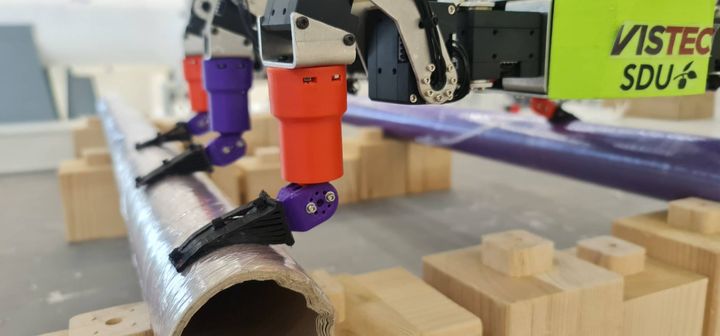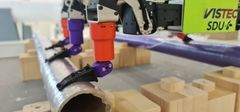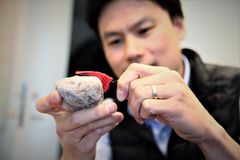In the future, robots will grasp like crickets: Breakthrough research inspired by insects can give robots a better grip

By Jakob Haugaard Christiansen
It may look very technical when robots walk and grip objects, but nature is the inspiration for many of their movements. Researchers from five countries have now refined a technique that can change the entire robot industry's way of producing grippers for robots.
For the past decades, the bending behaviour of a fish fin has been the go-to standard for the industry. The new research shows that it is a better idea to skip the waters and move to insects for inspiration. So says Poramate Manoonpong, professor at the Faculty of Engineering at the University of Southern Denmark, one of the five universities involved in the project.
- The traditional Fin Ray gripping mechanism has long been considered the most optimal form, and this is the first time anyone has looked at other methods. We could see that the angle of the attachment pads of the insect, like cricket, is different, he said.
Changing the angle
The Fin Ray-based gripping mechanism, proposed by the German biologist Leif Kniese, uses transverse beams of 90 degrees in the triangular shape. By adding force, the gripping mechanism bends "inward" around the object. By changing the angle of the transverse beams in the triangular shape from 90 degrees to other degrees (e.g., 10 or 30 degrees) inspired by the insect' attachment pads, the gripping mechanism will bend even more around the object while using much less force or energy.
- It means that we can save up to 20 % of the energy. It also means that we can take a gentler approach and use the gripping mechanism for a robot gripper to handle very delicate and fragile items, like foods, and apply significantly less force or energy in the meantime. It could have an impact on the way the entire industry makes grippers, says Poramate Manoonpong.
Revolutionizing grippers and feet
The new gripping technology can also improve a robot's feet. With insect-inspired feet resembling flippers, robots will get a better grip and walk safely along, for instance, an oil pipe to perform inspections.
When the researchers applied the foot with a 10 degrees angle to each leg of a six-legged robot and let it walk on pipes and rocky ground, they found that the robot managed without complex control. It indicates that robots can achieve motion intelligence through the body rather than the brain.
- We have worked on the project since 2018, and are very excited about the results, concludes Poramate Manoonpong.
Contacts
Jane Thoning CallesenAfdelingschef, TEK KommunikationSyddansk Universitet / The University of Southern Denmark
Tel:93507540jtca@tek.sdu.dkImages
Links
About Syddansk Universitet
About the project
An international team of researchers led by professor Poramate Manoonpong from the Faculty of Engineering at the University of Southern Denmark has constructed a new generation of robot grippers and feet with inspiration from insects.
By zooming in on the foot of insects, the researchers found that it makes sense to change the angle of the load-bearing beams in, for instance, a triangular gripper. Changing the so-called crossbeams' angle from 90 to 10 degrees makes it easier for the robot to grab objects.
The method can also be applied to a robot foot, as it will ensure a more robust grip around objects such as pipes or rocky ground, where a standard round foot would complicate the robot's gait and require more energy.
In addition to professor Poramate Manoonpong and his colleague Jørgen C. Larsen from the University of Southern Denmark, researchers from Kiel University in Germany, London South Bank University, Islamic Azad University in Iran, and Vidyasirimedhi Institute of Science and Technology in Thailand have contributed to the research result, which is published in the acclaimed international journal Advanced Intelligent Systems.
Subscribe to releases from Syddansk Universitet
Subscribe to all the latest releases from Syddansk Universitet by registering your e-mail address below. You can unsubscribe at any time.
Latest releases from Syddansk Universitet
Den første LEGO® Chair er fundet til SDU Vejle4.11.2025 10:51:09 CET | Pressemeddelelse
Med ansættelsen af Davide Taibi som den ene af to LEGO® Chair centerledere til Syddansk Universitets kommende campus i Vejle bliver der sat en tydelig forskningsmæssig retning for det nye forsknings- og uddannelsesmiljø.
Unge, der er utilfredse med deres krop, dropper oftere ud af deres ungdomsuddannelse29.10.2025 11:00:40 CET | Pressemeddelelse
Unge, der føler sig for tykke eller for tynde, har markant større risiko for ikke at gennemføre deres ungdomsuddannelse. Det viser et nyt studie, som peger på, at de unges opfattelse af deres egen krop kan have lige så stor eller endda større betydning for skolefrafald end deres faktiske vægt.
Mikroalger og kunstig intelligens kommer Østersøen til undsætning23.10.2025 10:23:22 CEST | Pressemeddelelse
Med mikroalger som levende sensorer vil et ambitiøst dansk-tyskt forskningsprojekt bygge en digital tvilling af Østersøen – og give politikere og borgere et demokratisk værktøj til at teste, hvilke løsninger der rent faktisk virker mod iltsvind og algeopblomstring.
Splittede forældre har svært ved at navigere i deres børns skærmbrug23.10.2025 09:32:41 CEST | Pressemeddelelse
Nyt studie viser, at forældre kæmper med at finde balancen i deres børns skærmbrug: For meget skærm opleves som bekymrende og i modstrid mod forældrenes værdier og opfattelse af det gode børneliv – omvendt kan skærmen også give børnene noget godt.
Erfaren universitetsdirektør fortsætter på SDU21.10.2025 14:39:34 CEST | Pressemeddelelse
SDU’s bestyrelse har forlænget ansættelsen af universitetsdirektør Thomas Buchvald Vind, der siden 2017 har stået i spidsen for universitetets administration.
In our pressroom you can read all our latest releases, find our press contacts, images, documents and other relevant information about us.
Visit our pressroom


